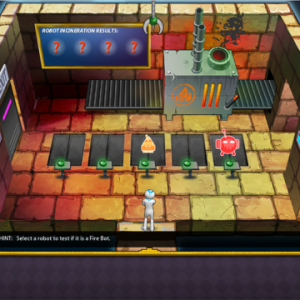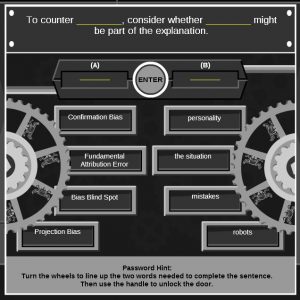For Rosa Mikeal Martey, professor in Journalism and Media Communication, the relationship between identity in the offline world and identity construction in a virtual world has always been of research interest. For her dissertation, Martey studied gender identity and perception in online job applications. Her current research involves understanding how social norms develop in digital spaces. “I’m interested in the way people interact with, use, and respond to technology as they perform and craft those identities,” she says. “Identity is a fluid category that emerges in different spaces and is influenced by the space itself.”
To study those spaces and the ways identity is created, Martey has participated in three major projects funded by Intelligence Advanced Research Projects Activity (IARPA) that explore how digital technology is used for education and exploration.
SCRIBE (Social and Cultural Research in Bounded Environments) investigated how people pick their avatars and interact on screen and how people present themselves based on gender and age. “One of our questions was: if we watch people online, can we tell who they are offline,” says Martey.
To do this, the researchers created a mini game within the multiplayer games World of Warcraft and Second Life and found that there are a few ways you can tell who is behind the elf, orc, or goblin you see on the screen, but not many.
In World of Warcraft, men use fewer smile emoticons, stand closer together, and make their avatars jump up and down more often than women do. In both virtual worlds, younger players use more punctuation and fewer polite phrases like hello and thank you than older players.
Also in World of Warcraft about 23% of men use female avatars and 7% of women choose male avatars. “The men who gender switch aren’t trying to be a woman as a way to express their own identity, but rather are using the avatar as a puppet – they are controlling a character,” she says.
Whether someone is playing World of Warcraft or building a community in Second Life, identity is a large part of the game (and the fun), and social norms emerge within these worlds. “In these games, you design a character or avatar and interact with other people, so it’s a good environment to think about how social norms emerge,” she says.
The game was designed to evoke text chat conversation, group cooperation, and problem-solving through word puzzles, battles with researcher characters, and seeking quest information.
In the steam punk mystery game that Martey set up in Second Life, she found that players brought their identities and contexts from other spaces into this game. “All of that online identity design can be considered clothing. Just as someone might pick a fancy dress for a party, people are choosing a special outfit or identity for these online spaces,” she says.
Through a survey the researchers gave to players after the game, “What emerged was the ways people are using these spaces to express and communicate aspects of themselves. Gender switching is more common in World of Warcraft than Second Life. We wondered if we could tell if they are male via speech or some other way. But we found it would probably be tough to figure out who was playing an avatar with a gender different than their own – the differences are pretty small,” Martey says.
CYCLES (Cycles of Your Cognitive Learning, Engagement, and Schema) was a project designed to reduce people’s reliance on cognitive biases. “Unconscious bias affects our thinking and decision-making,” says Martey. “Using games was important because play-oriented learning is more exploratory.”
Researchers found that using a game set in an alien space carnival to teach about bias was very effective in helping to identify and remove biases. “This experiment was done in a playful manner and did not trigger realism,” she says. “When it’s a game, you change the contextual rules and step around a person’s resistance to the topic. For instance, online sexual harassment training can seem silly or unrealistic. But when you use an artificial world, you can elicit different results.”


In this project, Martey looked specifically at engagement and usability: what kinds of interactions, visuals, and social contexts were interesting to people. She looked at “what gets people hooked” and to click through the rest of the online training from a design perspective. “A lot of that is usability: don’t make people read paragraphs of text or watch long videos. Provide easy-to-digest and skim pieces that are obviously and clearly connected and useful,” she says. “Keeping the game usable and engaging is crucial for teaching people complex ideas like unconscious biases, because if people disconnect from the game, they can’t learn the difficult details of the educational content.”
In the third project, TRACE (Trackable Reasoning and Analysis for Collaboration and Evaluation), Martey and co-researchers created a digital workspace with training on how to assess a variety of documents in decision-making. The target audience was government intelligence analysts who often have to sift through and synthesize an immense amount of data and information. In the experiment, trainees were asked to assess whether or not a building was holding weapons. Trainees were tested on how well they brought together the information (memos, interviews, photographs, traffic patterns) they gathered to write an intelligence report. The experimenters evaluated how the trainees compared information sources to avoid confirmation bias, how they wrote summaries and matched sources, ultimately indicating how good the report was.
Digital Technology for Education and Exploration
Whether looking at how virtual identity is created and social norms are developed, or how games can elicit better learning outcomes than other media-based teaching techniques, Martey and her collaborators are exploring art style, narrative complexity, communication style, and motivation to understand how we behave, interact, and learn online.
“Part of the approach we took [with these projects] was we moved away from the concept of “real life” vs. virtual life,” she says. “The screen is permeable. With everyone walking around with a phone in their hand, where does it [real life and virtual life] stop.”

